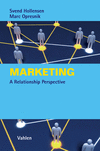Marketing
A Relationship Perspective
Zusammenfassung
Marketing – A Relationship Perspective
Moderne Grundlange zum Marketing
Das Lehrbuch behandelt eines der wichtigsten und aktuellsten Themenfelder des modernen Marketings. Der Ansatz verbindet dabei den klassischen Ansatz der strategischen Marketingplanung und seiner Instrumente mit dem neuen Ansatz des Relationship Marketing. Der ganzheitliche Ansatz des Buches umfasst dabei die aktuellen Marketing-Grundlagen, Praxisbeispiele sowie anwendungsorientierte Fallstudien und eignet sich somit ideal sowohl für Manager und Entscheidungsträger im Marketing-Bereich, Studenten in Bachelor- und Materstudiengängen sowie Dozenten und Trainer.
- Kapitel Ausklappen | EinklappenSeiten
- 1–14 Titelei/Inhaltsverzeichnis 1–14
- 15–57 1. Fundamentals of Relationship Marketing 15–57
- 15–21 1.1 The Evolution of Relationship Marketing 15–21
- 21–22 1.2 Definition of Relationship Marketing 21–22
- 22–28 1.3 Relationship Economics 22–28
- 28–31 1.4 Relationship Drivers 28–31
- 31–36 1.5 Relationship Marketing as an Integrative Management Approach 31–36
- 36–48 1.6 Fundamentals of Marketing Planning 36–48
- 48–57 Case 1: Nordex AG 48–57
- 57–123 2. Situational Analysis in the Marketing Planning Process 57–123
- 57–75 2.1 Assessing the Internal Marketing Situation 57–75
- 75–88 2.2 Assessing the External Marketing Situation 75–88
- 88–93 2.3 Analyzing Buying Behaviour on the B2C Market 88–93
- 93–96 2.4 Analyzing Buying Behaviour on the B2B Market 93–96
- 96–96 2.5 Comparing B2B and B2C Markets 96–96
- 96–110 2.6 SWOT Analysis 96–110
- 110–123 Case 2: BMW Motorcycles 110–123
- 123–185 3. Strategy Formulation in the Marketing Planning Process 123–185
- 123–149 3.1 Strategic Marketing Planning 123–149
- 149–180 3.2 Market Segmentation, Targeting and Positioning 149–180
- 180–185 Case 3: Royal Copenhagen A/S 180–185
- 185–358 4. Marketing Mix in the Marketing Planning Process 185–358
- 185–226 4.1 Product and Service Decisions 185–226
- 226–248 4.2 Pricing Decisions 226–248
- 248–286 4.3 Distribution Decisions 248–286
- 286–344 4.4 Communication Decisions 286–344
- 344–358 Case 4: Heinrich Deichmann GmbH 344–358
- 358–460 5. Implementation and Controlling in the Marketing Planning Process 358–460
- 358–388 5.1 Organizing and Implementing the Marketing Plan 358–388
- 388–401 5.2 Budgeting and Control 388–401
- 401–420 5.3 Ethical, Social and Environmental Aspects of Marketing Planning 401–420
- 420–445 5.4 Developing and Managing Customer Relationships 420–445
- 445–460 Case 5: Alfred Ritter GmbH 445–460
- 460–461 About the Authors 460–461
- 461–464 Index 461–464
- 464–464 Impressum 464–464


